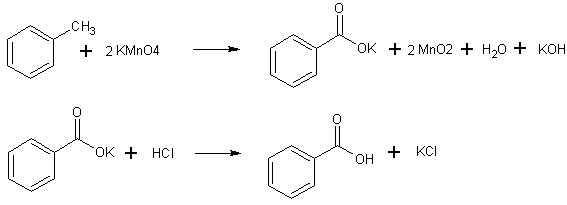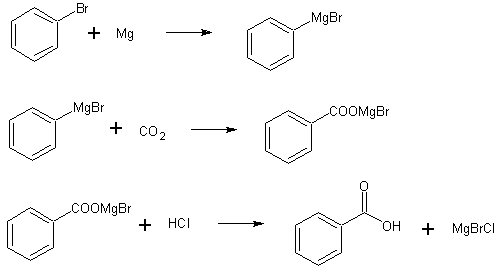Main page (Russian)
 Search in database (English)
Search in database (English)
Properties of substance:
benzoic acid
Group of substances:
organic
Physical appearance:
colorless monoclinic crystalsEmpirical formula (Hill's system for organic substances):
C7H6O2Structural formula as text:
C6H5COOHMolar/atomic mass: 122.1213
Melting point (°C):
122.375Boiling point (°C):
249Decomposition temperature (°C):
370
Solubility (g/100 g of solvent):
1,1,2-trichloro-1,2,2-trifluoroethane: soluble [Ref.]
1,4-dioxane: 55.3 (25°C) [Ref.]
1-propanol: 16.9 (-18°C) [Ref.]
1-propanol: 42.3 (23°C) [Ref.]
2-propanol: 48.5 (21.2°C) [Ref.]
acetone: 54.2 (20°C) [Ref.]
allyl alcohol: 33.4 (21.2°C) [Ref.]
ammonia liquid : 85 (20°C) [Ref.]
amyl acetate: 28.2 (25°C) [Ref.]
amyl alcohol: 47.86 (25°C) [Ref.]
benzene: 13.93 (25°C) [Ref.]
carbon disulphide: 5.06 (25°C) [Ref.]
carbon tetrachloride: 4.36 (25°C) [Ref.]
castor oil: 14.7 (25°C) [Ref.]
chloroform: 8.2 (5°C) [Ref.]
chloroform: 9.6 (10°C) [Ref.]
chloroform: 13.2 (20°C) [Ref.]
chloroform: 17.84 (25°C) [Ref.]
chloroform: 18.2 (30°C) [Ref.]
chloroform: 24.9 (40°C) [Ref.]
chloroform: 34.6 (50°C) [Ref.]
coconut oil: 4.98 (25°C) [Ref.]
cottonseed oil: 4.21 (25°C) [Ref.]
cyclohexane: 0.88 (10°C) [Ref.]
cyclohexane: 1.32 (20°C) [Ref.]
cyclohexane: 2.21 (30°C) [Ref.]
cyclohexane: 3.72 (40°C) [Ref.]
cyclohexane: 5.89 (50°C) [Ref.]
diethyl ether: 40 (15°C) [Ref.]
ethanol: 25.4 (-18°C) [Ref.]
ethanol: 38.9 (5°C) [Ref.]
ethanol: 42.8 (10°C) [Ref.]
ethanol: 47.1 (15°C) [Ref.]
ethanol: 52.4 (19.2°C) [Ref.]
ethanol: 52.8 (20°C) [Ref.]
ethanol: 55.9 (23°C) [Ref.]
ethanol: 64.6 (30°C) [Ref.]
ethanol: 81 (40°C) [Ref.]
ethanol: 101.1 (50°C) [Ref.]
ethanol abs.: 52.5 (20°C) [Ref.]
ethanol abs.: 65.8 (30°C) [Ref.]
ethyl acetate: 0.89 (-6.5°C) [Ref.]
ethyl acetate: 4.18 (21.5°C) [Ref.]
ethyl acetate: 10.6 (75°C) [Ref.]
ethylene glycol : 8.69 (18°C) [Ref.]
glycerol 98.5%: 2.2 (20°C) [Ref.]
heptane: 0.61 (5°C) [Ref.]
heptane: 0.74 (10°C) [Ref.]
heptane: 1.23 (20°C) [Ref.]
heptane: 1.86 (30°C) [Ref.]
heptane: 2.74 (40°C) [Ref.]
heptane: 4.16 (50°C) [Ref.]
hydrogen fluoride : very soluble [Ref.]
i-butanol: 18 (0°C) [Ref.]
iron pentacarbonyl: very slightly soluble [Ref.]
ligroin: 1.78 (25°C) [Ref.]
linseed oil: 4.26 (25°C) [Ref.]
methanol: 30 (-18°C) [Ref.]
methanol: 32.1 (-13°C) [Ref.]
methanol: 71.5 (23°C) [Ref.]
monochlorbenzene: 6.72 (14.2°C) [Ref.]
nitrobenzene: 11.17 (25°C) [Ref.]
olive oil: 4.22 (25°C) [Ref.]
pentane: 0.68 (5°C) [Ref.]
pentane: 0.85 (10°C) [Ref.]
pentane: 1.19 (20°C) [Ref.]
pentane: 1.88 (30°C) [Ref.]
phenol: 26.4 (40°C) [Ref.]
toluene: 4.8 (5°C) [Ref.]
toluene: 6 (10°C) [Ref.]
toluene: 8.8 (20°C) [Ref.]
toluene: 11.97 (25°C) [Ref.]
toluene: 12.9 (30°C) [Ref.]
toluene: 19.46 (40°C) [Ref.]
toluene: 28.7 (50°C) [Ref.]
trichloroethylene: 6.88 (15°C) [Ref.]
water: 0.1697 (0°C) [Ref.]
water: 0.18 (4°C) [Ref.]
water: 0.2096 (10°C) [Ref.]
water: 0.27 (18°C) [Ref.]
water: 0.34 (25°C) [Ref.]
water: 0.8428 (50°C) [Ref.]
water: 2.2 (75°C) [Ref.]
water: 3.135 (82.3°C) [Ref.]
water: 4.352 (90°C) [Ref.]
water: 6.708 (98.6°C) [Ref.]
xylene: 10.75 (25°C) [Ref.]
Numerical data:
Diffusion coefficient (cm2/s): 2.62E-5 (in acetone)
Density:
1.3211 (23.3°C, g/cm3)
1.07494 (130°C, g/cm3)
1.05218 (155°C, g/cm3)
1.02942 (180°C, g/cm3)
Synthesis 1:
Reference: Гитис С.С., Глаз А.И., Иванов А.В. Практикум по органической химии: Органический синтез. - М.: Высшая школа, 1991 pp. 221-222
In a round-bottom flask with a ball condenser 5,75 ml of toluene is boiled with 350 ml of water and 17 gr of fine-grained potassium permanganate. Several "boilers" is dropped into the flask for uniform boiling. After completion of the reaction the solution above precipitated manganese dioxide should be colourless. If the reaction mixture is coloured, discoloration is obtained by adding 1 ml of alcohol or oxalic acid with heating. The hot mixture is filtered through a folded filter, precipitated manganese dioxide is rinsed with a small amount of hot water. The filtrate is evaporated in a beaker until 50-100 ml volume and again precipitated manganese oxide (|V) is filtered. The precipitate is rinsed with 5 ml of hot water, the combined filtrate is acidified with concentrated hydrochloric acid until the acidic reaction on indicator paper. During this operation benzoic acid precipitates, it is filtered, rinsed with a small amount of cold water and dried.
The yield is 5 gr (75% from theory).
Synthesis 2:
Reference: Голодников Г.В. Практические работы по органическому синтезу. - Л.: ИЛУ, 1966 pp. 238-239
3,6 gr of magnesium chips is placed into a round-bottom flask with 500 ml volume and attached two-horned forste with a dropping funnel and a reflux condenser with a chloro-calcium tube, 50 ml of absolute ether is poured and a crystall of iodine is added, 5 ml of the mixture, containing 23,5 gr of bromobenzene in 50 ml of absolute ether, is added from the dropping funnel. If the reaction doesn't start by itself during several minutes (the ether should become cloudy and boil), the flask is placed on a bath with warm water and heated for some time until the beginning of the reaction. When the reaction starts, the water bath is moved away and ether solution of bromobenzene is added dropwise with that rate, which allows the ether to boil uniformly and not very rapidly all the time.
After addition of all bromobenzene the reaction flask is heated on a water bath for 1-1,5 h until the full dissolving of magnesium. Then the flask is cooled well by snow and salt, 30 ml of absolute ether is added and dropping funnel is changed by a gas tube, which reaches the bottom of the flask (the tube is chosen in advance), not very quick flow of carbon dioxide (from a Kipp generator or from a balon), which is dried previously by passing it through two washing flasks with sulfuric acid, is passed for 3-4 h.
Better results can be obtained, if solid carbonic acid is added to the ether solution of organomagnesium compound. In this case the dropping funnel is changed by a cork; pieces of solid carbon acid are added in small portions through the two-horned forste with periodic removing of the cork. Also strong cooling of the reaction mixture is obtained by this operation. Addition of solid carbon acid is stopped, when the reaction mixture thickens and the flask is covered outside by a layer of frost. It is forbidden to use solid carbon acid, which lied on the air longly and is covered by frost (moisture), before using big pieces of this carbon acid should be wiped with a dry rag, crashed quickly and small pieces is added to the flask.
The gas tube is changed by the dropping funnel and with continued cooling of the flask solution of 24 ml of concentrated hydrochloric acid in 24 ml of water is added dropwise. The decomposition is considered completed when the clear solutions (ether and water) is formed. The ether solution is seperated, and water solution is extracted with ether twice (20 ml of ether each time). Combined ether extractions are processed repeatedly with dilute solution of sodium hydroxide. Alkaline extraction is acidified with hydrochloric acid (on kongo) and precipitated benzoic acid is filtered, rinsed with a small amount of cold water and dried. Benzoic acid is recrystallised from hot water.
The yield is 9 gr (50% from theory). The melting point is 121. After sublimation the melting point is 122 C.
Reactions:
- Yeild 85-90%. [Ref.1
 ]
]
C6H5COOH + H2O2 → C6H5COOOH + H2O
- Yeild 72%. [Ref.1]
C6H5COOH + Cl2C=CClN(C2H5)2 → C6H5COCl + Cl2CHCON(C2H5)2
- Yeild 98%. [Ref.1
 ]
]
C6H5COOH + (COCl)2 → C6H5COCl + HCl + CO2 + CO
- Yeild 94%. [Ref.1
 ]
]
C6H5COOH + H2O2 → C6H4(OH)COOH + H2O
- Yeild 30%. [Ref.1
 ]
]
C6H5NSO + C6H5COOH → C6H5CONHC6H5 + SO2
- [Ref.1]
2C6H5COOH → C6H5C6H5 + 2CO2 + H2
Refractive index (nD):
1.504 (132°C)
1.53974 (20°C)
Vapour pressure (Torr):
10 (133°C)
Dissociation:
pKa (1) = 4.18 (25°C, water)
pKa (1) = 11 (25°C, dimethylsulfoxide)
pKa (1) = 6.21 (20°C, formamide)
Standard molar enthalpy (heat) of formation ΔfH (298 K, kJ/mol)
-385.2 (s) [Ref.]
-294 (g) [Ref.]
Standard molar entropy S (298 K, J/(mol·K))
167.6 (s) [Ref.]
Molar heat capacity at constant pressure Cp (298 K, J/(mol·K))
146.8 (s) [Ref.]
Enthalpy (heat) of fusion ΔfusH (kJ/mol)
18.02 (s) [Ref.]
Heat of combustion (kJ/mol)
3228.2 (s) [Ref.]
LD50 (mg/kg):
3300 (rats, oral)
References:
- Journal of Physical and Chemical Reference Data. - 2013. - Vol. 42, No. 3. - pp. 033103-1 - 033103-84
- Journal of Research of the National Bureau of Standards. - 1945. - Vol. 34. - pp. 333-372
- Jouyban A. Handbook of solubility data for pharmaceutacals. – CRC Press, 2010. - pp. 72-73
- Lewis R.J. Sax's Dangerous Properties of Industrial Materials. - 11ed. - Wiley-interscience, 2004. - pp. 379
- Seidell A. Solubilities of organic compounds. - 3ed., vol.2. - New York: D. Van Nostrand Company, 1941. - pp. 500-516
- Yalkowsky S.H., Yan H. Handbook of aqueous solubility data. - CRC Press, 2003. - pp. 369-372
- Аналитика и контроль. - 2018. - Т. 22, №2. - pp. 92-116 [DOI: 10.15826/analitika.2018.22.2.003] [Russian]
- Беликов В.Г. Учебное пособие по фармацевтической химии. - М.: Медицина, 1979. - pp. 169 [Russian]
- Вредные вещества в промышленности: Справочник для химиков, инженеров и врачей. - 7-е изд., Т.2. - Л.: Химия, 1976. - pp. 26 [Russian]
- Гитис С.С., Глаз А.И., Иванов А.В. Практикум по органической химии: Органический синтез. - М.: Высшая школа, 1991. - pp. 222 [Russian]
- Краткая химическая энциклопедия. - Т. 1: А-Е. - М.: Советская энциклопедия, 1961. - pp. 409-410 [Russian]
- Рабинович В.А., Хавин З.Я. Краткий химический справочник. - Л.: Химия, 1977. - pp. 129 [Russian]
- Реутов О.А., Курц А.Л., Бутин К.П. Органическая химия. - 2-е изд., Ч.1. - М.: Бином. Лаборатория знаний, 2005. - pp. 232 [Russian]
- Справочник коксохимика. - Т. 3. - Харьков: ИНЖЭК, 2009. - pp. 352-354 [Russian]
- Справочник по растворимости. - Т.1, Кн.1. - М.-Л.: ИАН СССР, 1961. - pp. 470, 910 [Russian]
- Справочник по растворимости. - Т.1, Кн.2. - М.-Л.: ИАН СССР, 1962. - pp. 1141, 1222, 1278, 1302, 1324, 1395, 1401, 1453, 1481-1485 [Russian]
- Химическая энциклопедия. - Т. 1. - М.: Советская энциклопедия, 1988. - pp. 267-268 [Russian]
Your requests if no data into database
© Collected Ruslan Anatolievich Kiper, burewestnik@mail.ru


